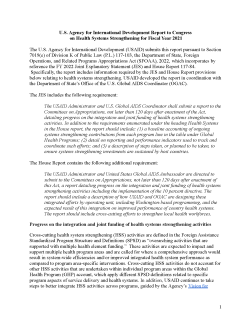Progress on the integration and joint funding of health systems strengthening activities
Cross-cutting health system strengthening (HSS) activities are defined in the Foreign Assistance Standardized Program Structure and Definitions (SPSD) as “overarching activities that are supported with multiple health element funding.” These activities are expected to impact and support multiple health program areas and are called for where a comprehensive approach would result in system-wide efficiencies and/or improved integrated health system performance as compared to program area-specific interventions. Cross-cutting HSS activities do not account for other HSS activities that are undertaken within individual program areas within the Global Health Program (GHP) account, which apply different SPSD definitions related to specific program aspects of service delivery and health systems. In addition, USAID continues to take steps to better integrate HSS activities across programs, guided by the Agency’s Vision for Health System Strengthening 2030, which serves as the overarching Agency policy on strengthening health systems.
To address the House Report 10 percent directive, the Bureau for Global Health (GH) has updated the FY 2022 Operational Plan Technical Considerations and other programming guidance for all operating units to ensure that the directive language is added. The Office of Health Systems (OHS) has taken a number of critical steps to plan for the implementation of this important directive, including meeting with all technical offices to ensure they understand what will be required, as well as presenting the directive and its implications for programming to the USAID’s GH Field Advisory Council. OHS is also conducting further outreach to USAID Regional Bureaus and Missions with health programming through webinars and through GH’s Country Team structure. OHS will continue to work closely with program area technical experts to provide Operating Units (OUs) technical assistance as they proceed with integrated efforts to meet the directive. In addition, individual program areas are developing illustrative examples of integrated HSS investments that align with program area objectives that can be shared with the field.
Within USAID OUs, teams from each program area are reviewing their cross-cutting HSS programming, identifying any challenges within program areas to meet the directive, as well as how additional investments and/or shifted relevant attribution are needed to meet the directive and advance investments in cross-cutting HSS. These investments will be programmed in the FY 2022 Operational Plan process, which captures all Global Health Programs with the exception of HIV/AIDS. PEPFAR’s Country Operational Planning (COP) process was used to plan increased and better integrated cross-cutting health system strengthening programming for COP22. PEPFAR’s COP 2022 guidance emphasized that critical public health systems capabilities must be addressed for long-term HIV epidemic control.
The directive implementation will also support efforts to strengthen the health workforce. A comprehensive, trained, protected, well-equipped, and supported workforce is a key component of any health system and is the backbone for primary health care, as it allows for the expansion of equitable access to public health services and health care across the globe. Comprehensive and sustainable investments in a country’s health workforce not only improve health outcomes, but also create jobs and career pathways, which support broader economic development.

